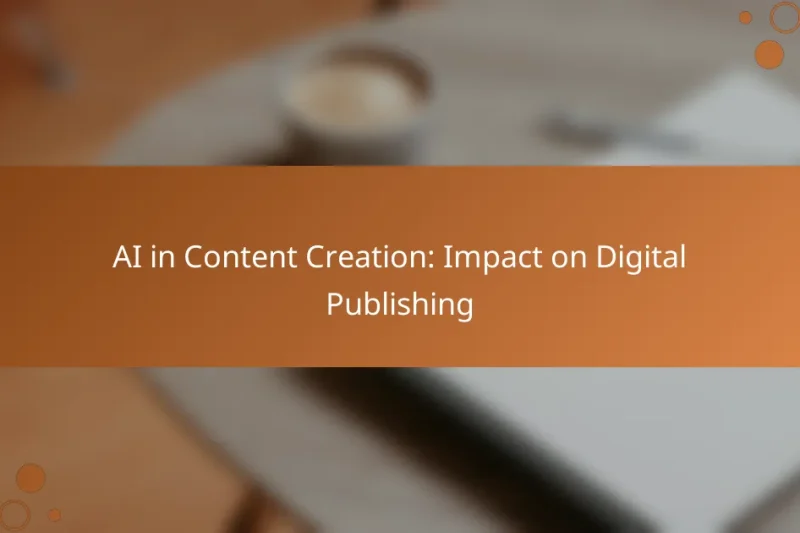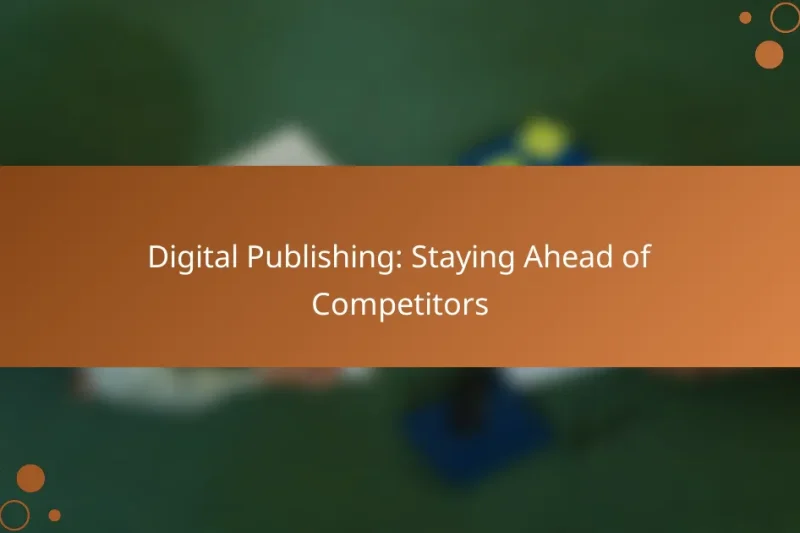Subscription services have transformed the landscape for digital product creators by ensuring a reliable income and … Subscription Services: Implications for Digital Product CreatorsRead more
Digital Products: Trends in Publishing
The landscape of digital publishing is rapidly evolving, marked by the increasing popularity of eBooks and self-publishing platforms. As subscription models gain traction and AI-driven content creation emerges, authors and publishers are finding new ways to connect with audiences and adapt to market demands. This transformation enhances accessibility and global reach, offering valuable insights for effective product creation and promotion.
Digital Products: Adapting to Changing Preferences
In today’s fast-paced digital landscape, businesses must adapt their products to meet the evolving preferences of … Digital Products: Adapting to Changing PreferencesRead more
Consumer Behavior: Trends in Digital Product Purchases
In recent years, consumer behavior in digital product purchases has evolved dramatically, driven by mobile shopping, … Consumer Behavior: Trends in Digital Product PurchasesRead more
Audio Content: Future Trends and Consumer Expectations
The future of audio content is being shaped by evolving consumer preferences and technological advancements, with … Audio Content: Future Trends and Consumer ExpectationsRead more
AI in Content Creation: Impact on Digital Publishing
AI is revolutionizing content creation in digital publishing by streamlining processes, personalizing experiences, and optimizing SEO … AI in Content Creation: Impact on Digital PublishingRead more
Digital Publishing: Staying Ahead of Competitors
In the competitive landscape of digital publishing, staying ahead requires a strategic approach that incorporates technology, … Digital Publishing: Staying Ahead of CompetitorsRead more
E-books: Emerging Trends and Consumer Insights
The e-book landscape is evolving rapidly, influenced by consumer preferences and technological innovations. Trends such as … E-books: Emerging Trends and Consumer InsightsRead more
What are the current trends in digital publishing?
Current trends in digital publishing include the growing popularity of eBooks, the rise of self-publishing platforms, and the increased use of multimedia content. Additionally, subscription models are gaining traction, and AI-driven content creation is emerging as a significant force in the industry.
Growth of eBooks
The growth of eBooks has transformed the publishing landscape, with millions of titles available across various platforms. Readers appreciate the convenience of accessing books on multiple devices, leading to a steady increase in eBook sales, which now account for a significant portion of the overall book market.
Publishers should consider optimizing their eBook formats for different devices and ensuring compatibility with popular eReaders. Offering features like adjustable font sizes and interactive elements can enhance the reading experience and attract more readers.
Rise of self-publishing platforms
Self-publishing platforms have democratized the publishing process, allowing authors to publish their works without traditional gatekeepers. Services like Amazon Kindle Direct Publishing and Smashwords enable writers to reach global audiences with relative ease.
Authors should be aware of the marketing and distribution challenges that come with self-publishing. Building a personal brand and engaging with readers through social media can significantly enhance visibility and sales.
Increased use of multimedia content
Multimedia content is becoming increasingly prevalent in digital publishing, with authors incorporating videos, audio, and interactive elements into their works. This trend enhances reader engagement and provides a richer experience compared to traditional text-only formats.
Publishers should explore tools and platforms that facilitate the integration of multimedia elements. However, it’s essential to balance content quality with multimedia use, as excessive elements can distract from the core message.
Focus on subscription models
Subscription models are reshaping how readers access content, with services like Scribd and Kindle Unlimited offering unlimited reading for a monthly fee. This model encourages readers to explore new genres and authors without the commitment of purchasing individual titles.
Publishers should evaluate the potential benefits of subscription services for their catalogs. Offering exclusive content or early access to new releases can attract subscribers and enhance loyalty.
Emergence of AI-driven content creation
AI-driven content creation is gaining traction, with tools that assist in writing, editing, and even generating entire articles. These technologies can streamline the publishing process and help authors produce content more efficiently.
While AI can enhance productivity, authors should remain vigilant about maintaining their unique voice and style. It’s crucial to use AI as a tool rather than a replacement for human creativity, ensuring that the final product resonates with readers.
How are digital products transforming the publishing industry?
Digital products are revolutionizing the publishing industry by enhancing accessibility, expanding global reach, and providing real-time data insights. These changes allow authors and publishers to connect with audiences more effectively and adapt to market demands swiftly.
Enhanced accessibility for authors
Digital platforms enable authors to publish their work without traditional barriers, such as high printing costs or the need for a publishing house. Self-publishing options, e-books, and online distribution channels allow writers to reach readers directly.
This accessibility fosters a diverse range of voices and genres, as authors from various backgrounds can share their stories. Tools like social media and blogging platforms further enhance visibility and engagement with potential readers.
Global reach for niche markets
Digital publishing allows authors to target niche markets across the globe, breaking geographical limitations. For instance, an author in Europe can easily sell e-books to readers in Asia or North America, tapping into specific interests and communities.
This global reach is particularly beneficial for genres that may not have a large audience in traditional publishing but have passionate followers online. Digital marketing strategies, such as social media advertising, can effectively promote these niche products to the right audience.
Real-time analytics for publishers
Publishers can leverage real-time analytics to track reader engagement and sales performance, allowing for data-driven decisions. Metrics such as download rates, reader demographics, and feedback can inform marketing strategies and content development.
By analyzing this data, publishers can quickly adapt their offerings to meet audience preferences, optimizing pricing strategies and promotional efforts. This agility is crucial in a fast-paced digital environment where trends can shift rapidly.
What are the best practices for creating digital products?
Creating digital products effectively involves understanding your audience, optimizing for search engines, and promoting through social media. These best practices can significantly enhance the product’s reach and user engagement.
Understanding target audience needs
Identifying the needs of your target audience is crucial for developing relevant digital products. Conduct surveys, interviews, or use analytics tools to gather insights about their preferences and pain points.
Once you have this information, tailor your product features and content to address these specific needs. For instance, if your audience values quick access to information, consider creating concise, easy-to-navigate digital formats.
Utilizing SEO strategies effectively
Effective SEO strategies are essential for increasing the visibility of your digital products. Start by researching relevant keywords that your target audience is likely to use when searching for products like yours.
Incorporate these keywords naturally into your product descriptions, titles, and metadata. Regularly updating your content and ensuring it is mobile-friendly can also improve your search engine rankings.
Leveraging social media for promotion
Social media platforms are powerful tools for promoting digital products. Identify which platforms your target audience frequents and create tailored content for each one to engage users effectively.
Consider using a mix of organic posts and paid advertising to maximize reach. Engaging visuals, informative videos, and user-generated content can enhance your promotional efforts and drive traffic to your digital products.
What tools are essential for digital publishing?
Essential tools for digital publishing streamline the creation, management, and distribution of content. Key options include design software, writing applications, website management platforms, and email marketing services.
Canva for design
Canva is a user-friendly graphic design tool that allows publishers to create visually appealing content without extensive design skills. It offers a wide range of templates for social media posts, eBooks, and marketing materials.
When using Canva, consider its drag-and-drop interface and extensive library of images and fonts. This can save time and enhance the quality of your visuals, making your content more engaging.
Scrivener for writing
Scrivener is a powerful writing application designed for long-form content, making it ideal for authors and researchers. It allows users to organize notes, outlines, and drafts in one place, facilitating a more structured writing process.
Utilize Scrivener’s features like split-screen editing and project targets to track your progress. This can help maintain focus and improve productivity, especially for larger projects.
WordPress for website management
WordPress is a widely used content management system (CMS) that simplifies website creation and management. It offers numerous themes and plugins, allowing publishers to customize their sites to fit their branding and functionality needs.
When setting up a WordPress site, choose a reliable hosting provider and consider security plugins to protect your content. Regular updates and backups are also crucial to maintaining site integrity and performance.
Mailchimp for email marketing
Mailchimp is an email marketing platform that helps publishers manage their subscriber lists and create effective email campaigns. Its automation features allow for personalized communication, which can enhance audience engagement.
To maximize Mailchimp’s effectiveness, segment your audience based on interests and behaviors. This targeted approach can lead to higher open and click-through rates, ultimately improving your marketing outcomes.
What are the challenges in digital publishing?
Digital publishing faces several challenges, including copyright issues, technological changes, and market competition. These factors can significantly impact content distribution, monetization, and audience engagement.
Copyright issues
Copyright issues are a major concern in digital publishing, as they can lead to legal disputes and financial losses. Publishers must navigate complex copyright laws that vary by country, ensuring they have the right to use and distribute content.
To mitigate copyright risks, it is essential to obtain licenses for any third-party material and to understand fair use policies. For example, using short excerpts of text or images may fall under fair use, but this can vary widely based on jurisdiction.
Publishers should also consider implementing digital rights management (DRM) tools to protect their content from unauthorized distribution. However, it’s important to balance protection with user experience, as overly restrictive measures can deter readers.






